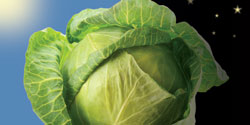Day/night cycle improves produce health; UV/LEDS keep strawberries fresher longer
CUTTING EDGE TECHNOLOGY
 Day/night cycles improve health of stored produce
Day/night cycles improve health of stored produce
Researchers at Rice University and the University of California-Davis have found that storage conditions affect the levels of pest-fighting compounds and antioxidants in postharvest fruits and vegetables. According to Rice biologist Janet Braam, lead researcher on the study “Postharvest Circadian Entrainment Enhances Crop Pest Resistance and Phytochemical Cycling” published in Cell Biology, vegetables and fruits don’t die the moment they are harvested and respond to their environment for several days. Exposing the produce to light/dark cycles prompted them to produce more cancer-fighting antioxidants at certain times of the day.
The researcher simulated day-night cycles of light and dark to control the internal biological clocks or circadian rhythms of fruits and vegetables, including cabbage, carrots, squash, and blueberries. Controlling these rhythms affect’s the produce’s nutritional value. In the cabbage experiments, the researchers found they could manipulate cabbage leaves to increase their production of anti-insect metabolites at certain times of the day. Glucosinolates, anti-cancer compounds that have been previously studied in broccoli and other cruciferous vegetables, peaked during daylight hours.
Their findings also suggest that storing fruits and vegetables in dark places, such as trucks, boxes, and refrigerators, may reduce their ability to keep daily rhythms.
The application of the research may change the way fruits and vegetables are transported and stored and displayed at grocery stores and in the home. In addition, utilizing day-night cycles for postharvest storage may ensure that the produce is processed (e.g., canning, freezing) at its peak nutritional profile.
UV-LEDS keep strawberries fresher longer
Researchers from the U.S. Dept. of Agriculture’s (USDA) Food Components and Health Laboratory, Beltsville, Md., and Sensor Electronic Technology, Inc. (SETi) Columbia, S.C., have demonstrated that low irradiance ultra-violet (UV) light directed at strawberries over long exposure periods at low temperature and very high humidity—typical home refrigerator conditions—delays spoilage and extends shelf life.
The researchers designed an innovative device incorporating light-emitting diodes (LEDs) that emit UV rays at the same wavelengths found in sunlight passing through the earth’s atmosphere.
The treatment has been shown to double the shelf life of the berries to nine days without mold. Berry freshness was judged by color of the fruit, weight, moisture content, concentration of select phytochemicals, visible damage, and mold growth. A control sample showed mold growth after seven days. The results are significant because previous attempts using traditional UV light sources for storage of produce resulted in severe drying, and it was unknown if the advantages of long exposure to low-level UV light would be effective against rot.
“UV-LEDs presented the opportunity to try low power devices that work well in the cold and can be engineered to work in small spaces such as refrigerator compartments,” said lead USDA researcher Steven Britz. Based on these encouraging results, the team is working to commercialize the technology for home refrigerators. “These findings are expected to have a major impact on the appliance business to extend the shelf life and preserve nutritional value of fresh produce while reducing waste and saving money for every household,” noted Remis Gaska, President and CEO of SETi.
LEDs are now commonplace thanks to their long life and energy efficiency, as well as their ability to span the wavelength range from near UV to infrared. The full UV spectrum, however, had presented challenges for LED manufacturers until recently. SETi developed a special technology to fabricate UV LEDs across the entire UV spectrum from UVA to UVC. This flexibility allowed them to tune the emitted light to the wavelengths most effective for this application. During the study, it was found that UV-B (equal energy) treatment prevented damaged areas of the strawberries from spreading while also inhibiting mold growth.
If you are working on or know of some cutting edge technology that you would like to be featured in this column, please send an email to [email protected]
